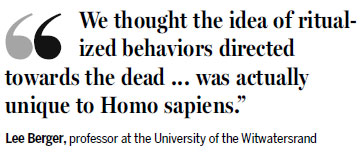Newly discovered bones reveal new human relative
Scientists say they've discovered a new member of the human family tree, revealed by a huge trove of bones in a barely accessible, pitch-dark chamber of a cave in South Africa.
The creature shows a surprising mix of humanlike and more primitive characteristics - some experts called it "bizarre" and "weird".
And the discovery presents some key mysteries: How old are the bones? And how did they get into that chamber, reachable only by a complicated pathway that includes squeezing through passages as narrow as 18 cm?
Experts say the bones were probably placed there after death - a discovery that shines fresh light on the origin of mankind.
"We have just met a new species of human relative that deliberately disposed of its dead," Lee Berger, research professor at the University of the Witwatersrand in Johannesburg, announced as the fossils were unveiled.
"Until this moment in history, we thought the idea of ritualized behaviors directed towards the dead ... was actually unique to Homo sapiens.
"We saw ourselves as different. We have now seen, we believe, a species that had that same capability - and it is an extraordinary thing."
The site, about 50 miles northwest of Johannesburg, has yielded about 1,550 specimens since its discovery in 2013. The fossils represent at least 15 individuals.
Researchers named the creature Homo naledi. That reflects the "Homo" evolutionary group, which includes modern people and our closest extinct relatives, and the word for "star" in a local language. The find was made in the Rising Star cave system.
The creature, which evidently walked upright, represents a mix of traits. For example, the hands and feet look like Homo, but the shoulders and the small brain recall Homo's more apelike ancestors, the researchers said.
Berger said naledi's anatomy suggest that it arose at or near the root of the Homo group, which would make the species about 2.5 million to 2.8 million years old. The discovered bones themselves may be younger, he said.
The researchers announced the discovery on Thursday in the journal eLife and at a news conference in the Cradle of Humankind, a site near the village of Magaliesburg. They said they were unable to determine an age for the fossils because of unusual characteristics of the site, but that they are still trying.
AP - AFP

(China Daily 09/11/2015 page11)












